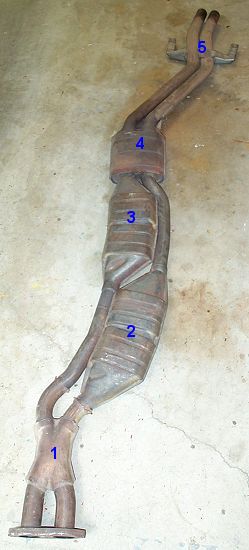|
|
| The BMW Motorsport solution to the catalytic converter section (i.e. center section) on the E30 M3 is useful to examine. It gives a good idea of what the factory found to be the optimum compromise for power and sound quality. The catalytic converters were something they had to live with. The best that can be hoped for when inserting a flow restriction like a cat into an exhaust path is that the reduction in power will not be too great. Theory dictates that there will always be a reduction. |

The photo shows an E30 M3 center section which has been stripped of its heat shield. At (1) we see the X-Pipe. (2) and (3) are the two catalytic converters. BMW chose to run two separate pipes out to the back of the car from the X-Pipe. They could also have used a single tube, in which case the X-Pipe would have been a Y-Pipe. But it is obvious from their treatment at (5), where the tubes are significantly squished to pass under the subframe, that BMW was quite concerned with ground clearance. Thus a single pipe exit would be impractical as it would protrude quite a bit lower under the rear subframe. The dual exit pipes also change the sound quality of the exhaust tone. It is "possible" that BMW chose the dual outlet arrangement in the interest of power but from what I have learned so far this should not have made a very big difference. Once the exhaust pulses are past the "pressure tuned" part of the exhaust then it is best to let them exit as quickly as possible while not emitting too much noise. Thus whether there is one tube going back from the end of the pressure tuned section, or two tubes, should not matter much. Exhaust pulses arrive at the X-Pipe from one of the two tracts. At this point the negative pressure wave following the pulse can "pull" on the adjacent tract to help filling on another cylinder. Once past the X-Pipe an exhaust pulse has a choice of two possible paths to continue out to the back of the car. Most likely the pulse flow is evenly divided between the two tubes from the X-Pipe on back. This is an important distinction as before the X-Pipe the exhaust pulse is entirely on one of the header tracts or the other. But where exactly is the end of the pressure tuned section on the factory exhaust? Is it the X-Pipe? Possibly not. It is likely that the "resonator" at (4) is the end of the pressure tuned section. A resonator in the true sense is simply an open cavity. It allows exhaust pulse pressure waves to dissipate and effectively forms a "pressure wave terminator". Thus the distance from the X-Pipe (1) to the resonator (4) would be a critical dimension in terms of the factory pressure tuning. What happens with the exhaust after the resonator at (4) would be irrelevant to power as long as there is not too much flow restriction. Unfortunately there is a restriction at (5) in the form of crimped tubes. Ed. Note: Since I wrote the previous paragraph it has been brought to my attention by E30 M3 owner Carl Fuhrmann that the resonator on the factory center section is not hollow. Rather it is formed of two perforated tubes surrounded by fiberglass packing - i.e. it is a small muffler. Click here for a look. Since the perforated tubes inside a "straight through" muffler of any type are "seen" by the exhaust as an equivelant length of straight pipe (see below), then the factory resonator is unlikely to act as a pressure wave terminator. It is more likely that BMW included it in an effort to reduce sound levels. Also, although the design of the resonator does allow "communication" between the two exhuast pipes, this probably has little effect on tuning since individual exhaust pulses are evenly split between the two pipes after the x-junction. There is of course one final flow restriction, and this is the muffler. The factory muffler is a dual "straight through" design. Basically a pair of perforated tubes surrounded by fiberglass packing to absorb sound energy. The exhaust "sees" a straight through muffler as a straight section of pipe - thus it is not a pressure wave terminator. This type of muffler has been found in many tests to offer the lowest possible flow restriction while still adequately quieting the exhaust pulses. Note that the ability of a muffler to absorb sound is directly proportional to its size (and also its weight). In this regard the factory muffler is simply huge, and is also quite heavy. |
|
|
|
For custom stainless center sections check out Mario Langsten's site: Vintage Sports and Racing |
|
Mitch Herman also sells very nice center sections: Motorsport Imports |
|
Go to: Details of the X-Pipe |
|
|